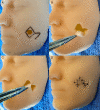Addressing the Pandemic Training Deficiency: Filling the Void with Simulation in Facial Reconstruction
- PMID: 33656188
- PMCID: PMC8013962
- DOI: 10.1002/lary.29490
Addressing the Pandemic Training Deficiency: Filling the Void with Simulation in Facial Reconstruction
Abstract
Objective/hypothesis: To assess the use of a three-dimensional (3D) printed, multilayer facial flap model for use in trainee education as an alternative method of teaching surgical techniques of facial reconstruction.
Study design: Cohort study.
Methods: A 3D printed facial flap simulator was designed from a computed tomography scan and manufactured out of silicone for low-cost, high-fidelity simulation. This simulator was tested by a group of Otolaryngology-Head and Neck Surgery trainees at a single institution. The simulator group was compared to a control group who completed an exercise on a traditional paper facial flap exercise. Both groups underwent didactic lectures prior to completing their respective exercises. Pre- and post-exercise Likert scale surveys measuring experience, understanding, effectiveness, and realism were completed by both groups. Central tendency, variability, and confidence intervals were measured to evaluate the outcomes.
Results: Trainees completing the facial flap simulator reported a statistically significant (p < 0.05) improvement in overall expertise in facial flap procedures, design of facial flaps, and excision of standing cutaneous deformities. No statistically significant improvement was seen in the control group.
Conclusions: Trainees found the facial flap simulator to be an effective and useful training tool with a high level of realism in surgical education of facial reconstruction. Surgical simulators can serve as an adjunct to trainee education, especially during extraordinary times such as the novel coronavirus disease 2019 pandemic, which significantly impacted surgical training.
Level of evidence: NA Laryngoscope, 131:E2444-E2448, 2021.
Keywords: COVID-19; Facial reconstruction; Mohs reconstruction; medical education; surgical simulation.
© 2021 The American Laryngological, Rhinological and Otological Society, Inc..
Figures


Similar articles
-
Computer-Aided Design, 3-D-Printed Manufacturing, and Expert Validation of a High-fidelity Facial Flap Surgical Simulator.JAMA Facial Plast Surg. 2019 Jul 1;21(4):327-331. doi: 10.1001/jamafacial.2019.0050. JAMA Facial Plast Surg. 2019. PMID: 31021369 Free PMC article.
-
To Pack a Nose: High-Fidelity Epistaxis Simulation Using 3D Printing Technology.Laryngoscope. 2022 Apr;132(4):747-753. doi: 10.1002/lary.29757. Epub 2021 Jul 17. Laryngoscope. 2022. PMID: 34272874
-
A Cost-Effective, Three-Dimensionally Printed Simulation Model Facilitates Learning of Bilobed and Banner Flaps for Mohs Nasal Reconstruction: A Pilot Study.Plast Reconstr Surg. 2024 Aug 1;154(2):358e-361e. doi: 10.1097/PRS.0000000000011037. Epub 2023 Sep 1. Plast Reconstr Surg. 2024. PMID: 37678816 Clinical Trial.
-
A systematic review of facial plastic surgery simulation training models.J Laryngol Otol. 2022 Mar;136(3):197-207. doi: 10.1017/S0022215121004151. Epub 2021 Dec 16. J Laryngol Otol. 2022. PMID: 34911591
-
Emerging Role of Three-Dimensional Printing in Simulation in Otolaryngology.Otolaryngol Clin North Am. 2017 Oct;50(5):947-958. doi: 10.1016/j.otc.2017.05.006. Epub 2017 Aug 31. Otolaryngol Clin North Am. 2017. PMID: 28838640 Review.
Cited by
-
Advancing Surgical Education: A Comprehensive Systematic Review with Meta-Analysis and Novel Approach to Training Models for Local Skin Advancement Flaps.Cureus. 2023 Jul 18;15(7):e42066. doi: 10.7759/cureus.42066. eCollection 2023 Jul. Cureus. 2023. PMID: 37602042 Free PMC article. Review.
-
Simulation models for learning local skin flap design and execution: A systematic review of the literature.Front Surg. 2022 Jul 20;9:918912. doi: 10.3389/fsurg.2022.918912. eCollection 2022. Front Surg. 2022. PMID: 35937603 Free PMC article. Review.
-
Comparing Feedback Techniques in Bilobe Flap Simulation Using 3D-Printed Facial Models.OTO Open. 2023 Nov 8;7(4):e90. doi: 10.1002/oto2.90. eCollection 2023 Oct-Dec. OTO Open. 2023. PMID: 38020044 Free PMC article.
-
Accurate resection of hilar cholangiocarcinoma using eOrganmap 3D reconstruction and full quantization technique.World J Gastrointest Surg. 2023 Aug 27;15(8):1693-1702. doi: 10.4240/wjgs.v15.i8.1693. World J Gastrointest Surg. 2023. PMID: 37701684 Free PMC article.
-
Simulation-based training in dermatologic surgery: a literature review.Arch Dermatol Res. 2023 Oct;315(8):2227-2232. doi: 10.1007/s00403-023-02606-5. Epub 2023 Apr 6. Arch Dermatol Res. 2023. PMID: 37024689 Review.
References
-
- Javia L, Sardesai MG. Physical models and virtual reality simulators in otolaryngology. Otolaryngol Clin North Am 2017;50:875–891. - PubMed
-
- Monfared A, Mitteramskogler G, Grube S, et al. High‐fidelity, inexpensive surgical middle ear simulator. Otol Neurotol 2012;33:1573–1577. - PubMed
-
- Ainsworth TA, Kobler JB, Loan GJ, Burns JA. Simulation model for transcervical laryngeal injection providing real‐time feedback. Ann Otol Rhinol Laryngol 2014;123:881–886. - PubMed
Publication types
MeSH terms
LinkOut - more resources
Full Text Sources
Other Literature Sources
Medical
Research Materials

